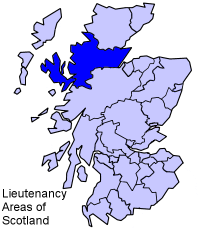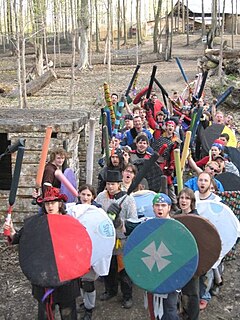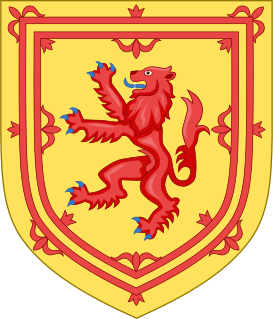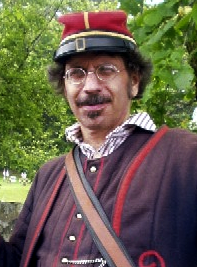
The Society for Creative Anachronism (SCA) is an international living history group with the aim of studying and recreating mainly Medieval European cultures and their histories before the 17th century. A quip often used within the SCA describes it as a group devoted to the Middle Ages "as they ought to have been", choosing to "selectively recreate the culture, choosing elements of the culture that interest and attract us". Founded in 1966, the non-profit educational corporation has over 20,000 paid members as of 2020 with about 60,000 total participants in the society.

The shires of Scotland, or counties of Scotland, are historic subdivisions of Scotland established in the Middle Ages and used as administrative divisions until 1975. Originally established for judicial purposes, from the 17th century they started to be used for local administration purposes as well. The areas used for judicial functions (sheriffdoms) came to diverge from the shires, which ceased to be used for local government purposes after 1975 under the Local Government (Scotland) Act 1973.

The Kingdom of England was a sovereign state on the island of Great Britain from 12 July 927, when it emerged from various Anglo-Saxon kingdoms, until 1 May 1707, when it united with Scotland to form the Kingdom of Great Britain.

Ross and Cromarty, sometimes referred to as Ross-shire and Cromartyshire, is a variously defined area in the Highlands and Islands of Scotland. There is a registration county and a lieutenancy area in current use, the latter of which is 8,019 square kilometres in extent. Historically there has also been a constituency of the Parliament of the United Kingdom, a local government county, a district of the Highland local government region and a management area of the Highland Council. The local government county is now divided between two local government areas: the Highland area and Na h-Eileanan Siar. Ross and Cromarty border Sutherland to the north and Inverness-shire to the south.

The Pennsic War is an annual American medieval camping event held by the Society for Creative Anachronism (SCA), a "war" between two large regional SCA groups: the Kingdom of the East and the Middle Kingdom. It is the single largest annual SCA event, with more than 10,000 people attending each year, from as far as China, South Korea, Sweden, Germany, France, Italy, Greece, and Australia.

Amtgard is a battle gaming and live-action fantasy roleplaying and boffer combat game with chapters primarily based in the United States and Canada as well as Germany, Croatia, and South Korea.
The Kingdom of Lochac is one of twenty "Kingdoms" or regions, of the Society for Creative Anachronism (SCA) - an international organization dedicated to researching and recreating aspects of the Middle Ages.

The West Kingdom is the oldest kingdom of the historical reenactment organization, the Society for Creative Anachronism. It comprises Northern California, Nevada, Alaska, Japan, Korea and the Pacific Rim.

Medieval reenactment is a form of historical reenactment that focuses on re-enacting European history in the period from the fall of Rome to about the end of the 15th century. The second half of this period is often called the Middle Ages. This multiplicity of terms is compounded by the variety of other terms used for the period.
Rapier Combat is a style of historical fencing practiced in the Society for Creative Anachronism (SCA). The primary focus is to study, replicate and compete with styles of rapier sword-fighting found in Europe during the Renaissance period, using blunted steel swords and a variety of off-hand defensive items. Participants wear period clothing while competing, along with or incorporating protective equipment for safety. In the April 2020 update of the rules, the sport was renamed 'Fencing Combat'.

The History of local government in Scotland is a complex tale of largely ancient and long established Scottish political units being replaced after the mid 20th century by a frequently changing series of different local government arrangements.

The Great Dark Horde is an independent "household" within the Society for Creative Anachronism (SCA), a historical reenactment group founded with the aim of studying and recreating pre-17th century Western European cultures and their histories. Although one can also find members in other re-enactment groups, it may very well be the largest household in that organization. It covers all the Kingdoms, though in some Kingdoms members do not always advertise themselves as Hordesmen.

Northern Ireland is divided into six counties, namely: Antrim, Armagh, Down, Fermanagh, Londonderry and Tyrone. Six largely rural administrative counties based on these were among the eight primary local government areas of Northern Ireland from its 1921 creation until 1973. The other two local government areas were the urban county boroughs of Derry and Belfast.
The Society for Creative Anachronism (SCA) is a medieval reenactment group with an international membership, founded in California in 1966. Members of the group participate, to a greater or lesser extent, in a wide variety of activities based on those found in pre-1601 CE cultures. The vast majority of interests in the SCA are either combat-focused, or focused on the day-to-day crafts of the period, known within the Society as A&S. Gatherings of the SCA are events, at which attempts at pre-17th century costume must be worn, and practices or meetings, at which costuming is largely up to each member's discretion—although sufficient safety equipment must always be worn for practicing combat skills.
Historical re-enactment in Australia has been occurring since at least the early 1970s. With no conventional land battles and few protracted civil disturbances since the British colonisation of Australia, most military re-enactment in Australia focuses on events from other countries, including the European Feudal, medieval, and renaissance eras.

Patri J. Pugliese was a historian of science, dance, and fencing, as well as a teacher of historical dance.

SCA armoured combat, or informally heavy combat, is a combat sport developed by the Society for Creative Anachronism (SCA) in which participants in protective body armour compete in mock combat, individual tournaments inspired by forms of historical combat, and tournament combat practiced in medieval Europe. Groups also compete, under supervision, in group battles which may approximate historically real combat, using SCA approved safe weapons. Combats are performed under the watch of marshals to maintain safety. It is variously considered a combat sport, contact sport, or a form of martial art.

Historically, Fermanagh, as opposed to the modern County Fermanagh, was a kingdom of Gaelic Ireland, associated geographically with present-day County Fermanagh. Fir Manach originally referred to a distinct kin group of alleged Laigin origins. The kingdom of Fermanagh was formed in the 10th century, out of the larger kingdom of Uí Chremthainn, which was part of the overkingdom of Airgíalla. By the late 11th century it had grown to cover all of what is now County Fermanagh. The kingdom came to be ruled by the Mag Uidhir (Maguire) clan from the late 13th century onward. They were based at Lisnaskea, and their royal inauguration site was nearby Sgiath Gabhra (Skeagoura), now called Cornashee. Under Hugh Maguire, Fermanagh was involved in the Nine Years' War against English rule. His successor, Cú Chonnacht Óg Mag Uidhir, was one of the Gaelic Irish leaders who fled Ireland during the Flight of the Earls. Fermanagh was subsequently merged into the Kingdom of Ireland as County Fermanagh.
Brian R. Price is an American university professor, author, editor, publisher, martial arts instructor of the Italian school of swordsmanship, reconstructive armorer, and member of the Society for Creative Anachronism. As of Nov. 10, 2022, Price is listed as Professor of Military and Security Studies, Air Command and Staff College Faculty, Air University. His previous association with Hawai'i Pacific University, ceased before Nov. 11, 2022, when he was not listed among the faculty there. He speaks regularly at conferences both for his current field on counterinsurgency and in his earlier, and now secondary field, on chivalric topics. His page at https://hpu.academia.edu/BrianRPrice lists his current and recent research projects. He began his studies of medieval history in 1990, but began to shift his interests as the Afghan and Iraq wars progressed, increasingly emphasizing aspects of modern military theory, especially ways through which culture, doctrine and military practice interweave. These modern topics have been a prominent part of his work since his graduation from the University of North Texas and deployment to Afghanistan as part of the Human Terrain System in 2011-2012. He has spoken at the UK Ministry of Defence, at the Society for Military History, the World History Conference, several academic martial arts symposia, and appeared on television to discuss the situation in Ukraine.

An Act for the division of Meath into two shires was an Act of the Parliament of Ireland passed in 1542 which resulted in the division of County Meath, shired in 1297, into the counties of Meath and Westmeath. The Act commenced on Saint Catherine's Day in 1542 and remains in effect.

















